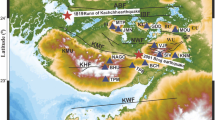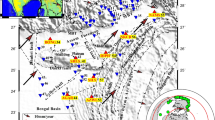Abstract
Teleseismic earthquake data recorded by 11 broadband digital seismic stations deployed in the India–Asia collision zone in the eastern extremity of the Himalayan orogen (Tidding Suture) are analyzed to investigate the seismic anisotropy in the upper mantle. Shear-wave splitting parameters (Φ and δt) derived from the analysis of core-refracted SKS phases provide first hand information about seismic anisotropy and deformation in the upper mantle beneath the region. The analysis shows considerable strength of anisotropy (delay time ~0.85–1.9 s) with average ENE–WSW-oriented fast polarization direction (FPD) at most of the stations. The FPD observed at stations close to the Tidding Suture aligns parallel to the strike of local geological faults and orthogonal to absolute plate motion direction of the Indian plate. The average trend of FPD at each station indicates that the anisotropy is primarily originated by lithospheric deformation due to India–Asia collision. The splitting data analyzed at closely spaced stations suggest a shallow source of anisotropy originated in the crust and upper mantle. The observed delay times indicate that the primary source of anisotropy is located in the upper mantle. The shear-wave splitting analysis in the Eastern Himalayan syntaxis (EHS) and surrounding regions suggests complex strain partitioning in the mantle which is accountable for evolution of the EHS and complicated syntaxial tectonics.







Similar content being viewed by others
References
Acharyya SK (2005) Geology and tectonics of NE India. J Geophys XXVI:35–49
Angelier J, Baruah S (2009) Seismotectonics in Northeast India: a stress analysis of focal mechanism solutions of earthquakes and its kinematic implications. Geophys J Int 178:753–774
Bai L, Iidaka T, Kawakatsu H et al (2009) Upper mantle anisotropy beneath Indochina block and adjacent regions from shear-wave splitting analysis of Vietnam broadband seismograph array data. Phys Earth Planet Int 176:33–43. doi:10.1016/j.pepi.2009.03.008
Christensen NI, Crosson RS (1968) Seismic anisotropy in the upper mantle. Tectonophysics 6:93–107
Copley A, McKenzie D (2007) Models of crustal flow in the India–Asia collision zone. Geophys J Int 169:683–698
DeMets C, Gordon RG, Argus DF et al (1990) Current plate motions. Geophys J Int 101:425–478
Ding L, Zhong D, Yin A, Kapp P et al (2001) Cenozoic structural and metamorphic evolution of the eastern Himalayan syntaxis (Namche Barwa). Earth Planet Sci Lett 192:423–438
England P, Houseman G (1986) Finite strain calculations of continental deformation 2. Comparison with the India–Asia collision zone. J Geophys Res 91:3664–3676
Flesch LM, Holt WE, Silver PG et al (2005) Constraining the extent of crust–mantle coupling in central Asia using GPS, geologic, and shear wave splitting data. Earth Planet Sci Lett 238:248–268. doi:10.1016/j.epsl.2005.06.023
Gansser A (1964) Geology of the Himalayas. Wiley, London
Gururajan NS, Choudhuri BK (2003) Geology and tectonic history of the Lohit Valley, Eastern Arunachal Pradesh. J Asian Earth Sci 21:731–741
Hall SA, Kendall JM, van der Baan M (2004) Some comments on the effects of lower mantle anisotropy on SKS and SKKS phases. Phys Earth Planet Int 146:469–481. doi:10.1016/j.pepi.2004.05.002
Hallet B, Molnar P (2001) Distorted drainage basins as markers of crustal strain east of the Himalaya. J Geophys Res 106:13697–13709. doi:10.1029/2000JB900335
Hazarika D, Arora BR, Bora C (2012) Crustal structure and deformation in the northeast India–Asia collision zone: constraints from receiver function analysis. Geophys J Int 188:737–749. doi:10.1111/j.1365-246X.2011.05267
Heintz M, Kumar VP, Gaur VK et al (2009) Anisotropy of the Indian continental lithospheric mantle. Geophys J Int 179:1341–1360. doi:10.1111/j.1365-246X.2009.04395.x
Hess H (1964) Seismic anisotropy of the uppermost mantle under oceans. Nature 203:629–631
Hirn A, Jiang M, Sapin M et al (1995) Seismic anisotropy as an indicator of mantle flow beneath the Himalayas and Tibet. Nature 375:571–574
Holt WE, Ni JF, Wallace TC, Haines AJ (1991) The active tectonics of the Eastern Himalayan syntaxis and surrounding regions. J Geophys Res 96:14595–14632
Huang WC, Ni JF, Tillman F et al (2000) Seismic polarization anisotropy beneath the central Tibetan Plateau. J Geophys Res 105:27979–27989
Jade S, Mukul M, Bhattacharyya AK et al (2007) Estimates of interseismic deformation in Northeast India from GPS measurements. Earth Planet Sci Lett 263:221–234. doi:10.1016/j.epsl.2007.08.031
Kennett BLN, Engdahl ER (1991) Travel times for global earthquake location and phase identification. Geophys J Int 105:429–465
Kennett BLN, Engdahl ER, Buland R (1995) Constraints on seismic velocities in the Earth from travel times. Geophys J Int 122:108–124. doi:10.1111/j.1365-246X.1995.tb03540.x
Lev E, Long MD, van der Hilst RD (2006) Seismic anisotropy from shear-wave splitting in Eastern Tibet reveals changes in lithospheric deformation. Earth Planet Sci Lett 251:293–304
Leven JN, Jackson L, Ringwood AE (1981) Upper mantle seismic anisotropy and lithospheric decoupling. Nature 289:234–239
Levin V, Park J (1998) P-SH conversions in layered media with hexagonally symmetric anisotropy: a cookbook. Pure Appl Geophys 151:669–697
Long MD, Silver PG (2009) Shear wave splitting and mantle anisotropy: measurements, interpretations, and new directions. Surv Geophys 30:407–461. doi:10.1007/s10712-009-9075-1
McNamara DE, Owens TJ, Silver PG et al (1994) Shear wave anisotropy beneath the Tibetan Plateau. J Geophys Res 99:13655–13665
McNamara DE, Walter WR, Owens TJ, Ammon CJ (1997) Upper mantle velocity structure beneath the Tibetan Plateau from Pn travel time tomography. J Geophys Res 102:493–506
Montagner JP, Nataf HC (1986) A simple method for inverting the azimuthal anisotropy of surface waves. J Geophys Res 91:511–520
Replumaz A, Tapponnier P (2003) Reconstruction of the deformed collision zone between India and Asia by backward motion of lithospheric blocks. J Geophys Res 108:2285. doi:10.1029/2001JB000661
Ribe NM (1992) On the relation between seismic anisotropy and finite strain. J Geophys Res 97:8737–8747
Savage MK (1999) Seismic anisotropy and mantle deformation: what have we learned from shear wave splitting? Rev Geophys 37:65–106
Shen F, Royden LH, Burchfi BC (2001) Large-scale crustal deformation of the Tibetan Plateau. J Geophys Res 106:6793–6816. doi:10.1029/2000JB900389
Shen ZK, Lu J, Wang M, Bürgmann R (2005) Contemporary crustal deformation around the southeast borderland of the Tibetan Plateau. J Geophys Res 110:B11409. doi:10.1029/2004JB003421
Silver PG (1996) Seismic anisotropy beneath the continents: probing the depths of geology. Annu Rev Earth Planet Sci 24:385–432
Silver PG, Chan WW (1988) Implications for continental structure and evolution from seismic anisotropy. Nature 335:34–39
Silver PG, Chan WW (1991) Shear wave splitting and subcontinental mantle deformation. J Geophys Res 96:16429–16454
Silver PG, Savage MK (1994) The interpretation of shear wave splitting parameters in the presence of two anisotropic layers. Geophys J Int 119:949–963
Silver PG, Kaneshima S, Meade C (1993) Why is the lower mantle so isotropic? Eos Trans AGU 74(16) Spring Meeting supp:313
Simons FJ, van der Hilst RD, Montagner JP, Zielhuis A (2002) Multimode Rayleigh wave inversion for heterogeneity and azimuthal anisotropy of the Australian upper mantle. Geophys J Int 151:738–754
Singh A, Kumar MR, Raju PS, Ramesh DS (2006) Shear wave anisotropy of the northeast Indian lithosphere. Geophys Res Lett 33:L16302. doi:10.1029/2006GL026106
Singh A, Kumar MR, Raju PS (2007) Mantle deformation in Sikkim and adjoining Himalaya: evidences for a complex flow pattern. Phys Earth Planet Int 164:232–241. doi:10.1016/j.pepi.2007.07.003
Sol S, Meltzer A, Burgmann R et al (2007) Geodynamics of the southeastern Tibetan Plateau from seismic anisotropy and geodesy. Geology 35:563–566. doi:10.1130/G23408A.1
Tapponnier P, Peltzer G, Le Dain AY et al (1982) Propagating extrusion tectonics in Asia: new insights from simple experiments with plasticine. Geology 10:611–616
Tapponnier P, Zhiqin X, Roger F, Meyer B et al (2001) Oblique stepwise rise and growth of the Tibetan Plateau. Science 294:1671–1677. doi:10.1126/scince.105978
Thakur VC, Jain AK (1975) Some observation on deformation, metamorphism and tectonic significance of the rocks of some parts of Mishmi hills, Lohit district (NEFA), Arunachal Pradesh. Him Geol 5:339–364
Vinnik LP, Farra V, Romanowicz B (1989) Azimuthal anisotropy in the earth from observations of SKS at Geoscope and NARS broadband stations. Bull Seismol Soc Am 79:1542–1558
Vinnik LP, Makeyeva LI, Milev A et al (1992) Global patterns of azimuthal anisotropy and deformations in the continental mantle. Geophys J Int 111:433–447
Wang E, Burchfiel BC (1997) Interpretations of Cenozoic tectonics in the right-lateral accommodation zone between the Ailo Shan shear zone and the Eastern Himalayan syntaxis. Int Geol Rev 39:191–219
Wang Q, Zhang PZ, Freymueller JT et al (2001) Present-day crustal deformation in China constrained by global positioning system measurements. Science 294:574–577
Zhang Z, Karato SI (1995) Lattice preferred orientation in olivine aggregates deformed in simple shear. Nature 375:774–777
Zhang Z, Yuan X, Chen Y et al (2010) Seismic signature of the collision between the east Tibetan escape flow and the Sichuan Basin. Phys Earth planet Int 292:254–264. doi:10.1016/j.epsl.2010.01.046
Acknowledgments
This study is supported by the Deep Continental Studies Program of Department of Science and Technology (DST), Government of India. The financial support and encouragement received from the DST and members of the project monitoring committee are acknowledged with thanks. The encouragement and facilities provided by the host Institution (WIHG, Dehradun) are recorded with gratitude. We are thankful to the scientists and technical staff of Geophysics Group, WIHG, for their kind encouragement and fruitful suggestions.
Author information
Authors and Affiliations
Corresponding author
Rights and permissions
About this article
Cite this article
Hazarika, D., Yadav, D.K., Sriram, V. et al. Upper mantle anisotropy beneath northeast India–Asia collision zone from shear-wave splitting analysis. Int J Earth Sci (Geol Rundsch) 102, 2061–2076 (2013). https://doi.org/10.1007/s00531-013-0922-4
Received:
Accepted:
Published:
Issue Date:
DOI: https://doi.org/10.1007/s00531-013-0922-4




